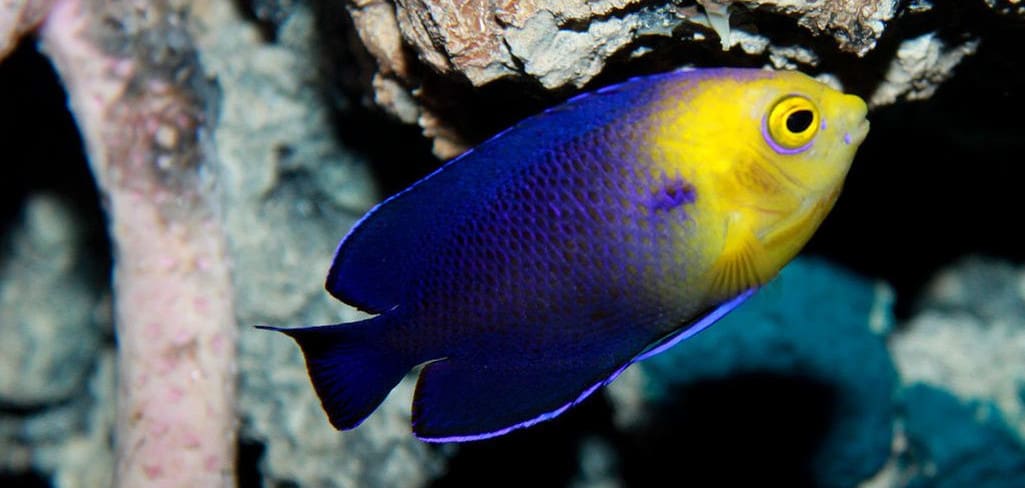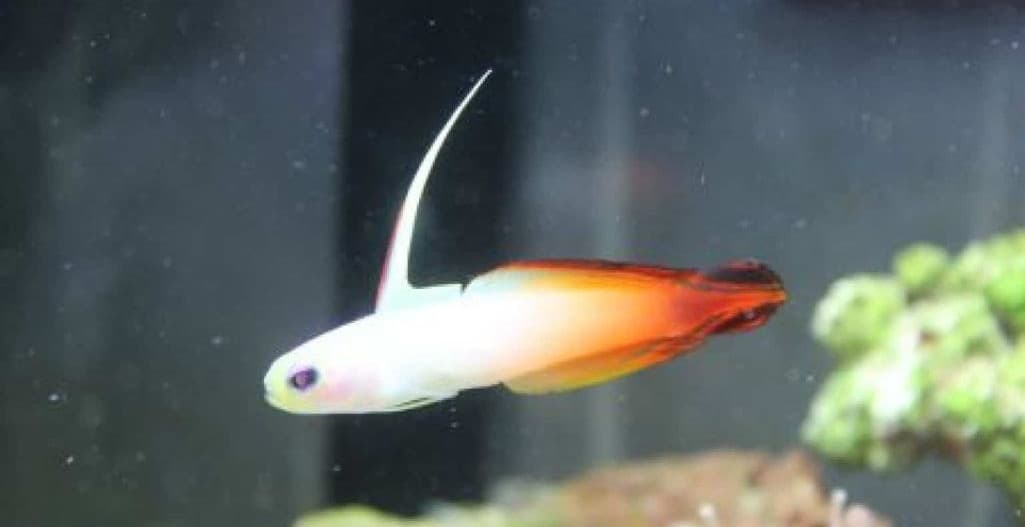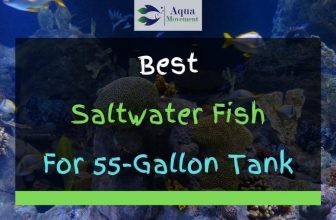16 Best Clownfish Tank Mates (With Pictures)
The Clownfish is a well-known tropical fish. Many love the Clownfish because of its fun behavior and vivid coloration.
Most Clownfish are found in the shallow waters of the Indian Ocean, the Red Sea, and the western Pacific. They frequent near coral reefs, sea anemones, and lagoons.
Contrary to pop culture which depicts it in orange color only, the Clownfish comes in the colors of orange, yellow, blue, and maroon.
Know that color depends on the variety or specie of the Clownfish.
The Clownfish is an ideal fish for learning fishkeeping. It’s a hardy fish that doesn’t require a large fish tank, resilient against changing water conditions, peaceful, and not very picky about food.
Clownfish are great on their own in the aquarium. However, it’s more fun to watch when they’re swimming with companions.
Thus, Clownfish is an ideal fish for community tanks.
So what are the best clownfish tank mates? Take time to read this list for you to find out.
Table of Contents
Basslet
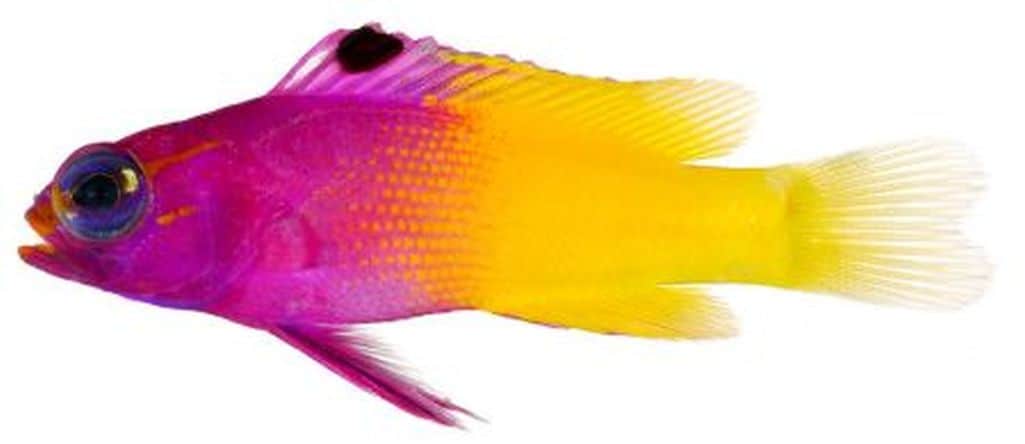
The Basslet is a common name for three varieties of fishes namely the common basslet, oceanic basslet, and fairy basslet.
Of all types of Basslet, the Royal Gramma is the most popular.
Royal Gramma is commonly found in tropical waters. It usually swims in depths of 2-60 meters. This fish frequents ledges and mini caves most of the time.
The Royal Gramma is a Basslet with very attractive coloration. Its body has a deep neon violet color. On the other hand, its tail showcases a bright hue of yellow.
This fish reaches a maximum size of 3 inches. The cheapest Royal Gramma has a price tag of $34 on average.
Royal Gramma is a basslet that’s very peaceful. However, it won’t think twice about attacking other fish that enters its territory.
Also, it loves to hide. Thus, you need to put lots of shelters like mini caves, rocks, and corals in the community tank.
For a quick trivia, the Royal Gramma Basslet is one of the most unique clownfish tank mates, because it can swim upside down.
Basslet Profile
- Other Names: Fairy Basslet
- Life Span: 5 Years
- Diet: Mysis Shrimp, Brine Shrimp, and Marine Plankton
- Preferred Water Condition: Saltwater, Acidic, Warm (22 – 25 degrees Celsius)
- Minimum Tank Requirement: 60 Gallons
- Suitable Tank Mates: Clownfish, Boxfish, Filefish, Rabbitfish, Squirrelfish, and Jawfish
Sea Anemone
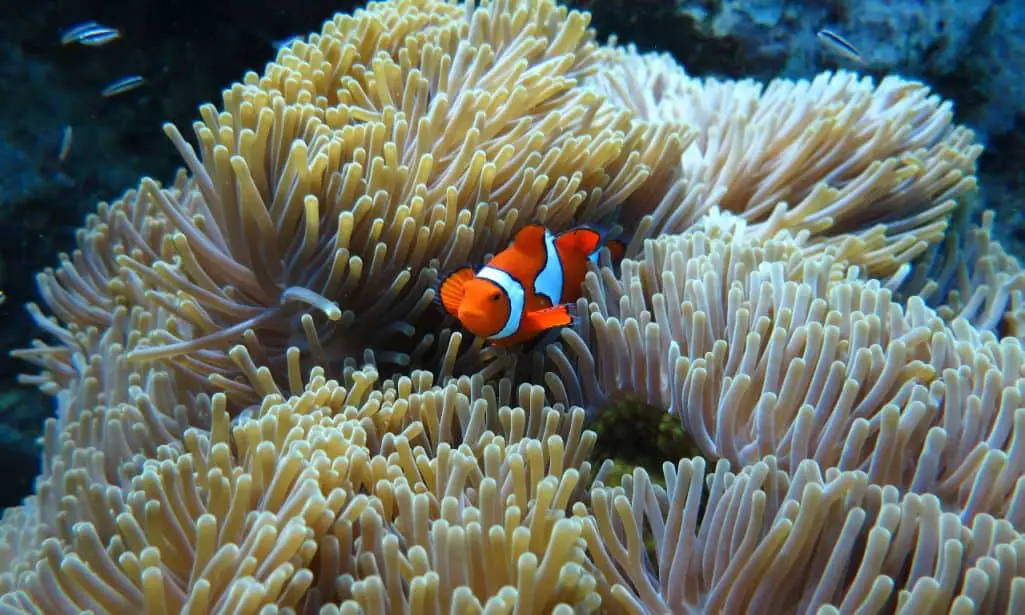
The Sea Anemone (Actiniaria) is present in all of the world’s oceans regardless of temperature.
It’s possible to find sea anemones on depths of more than 20,000 feet. Aside from seas, the Sea Anemone can live in brackish waters.
The most beautiful varieties of the Sea Anemone thrive on warm and shallow waters. They’re found lying stationary in the seabed near reefs and oceanic rocks.
A Sea Anemone that thrives in warm and shallow waters may come in pink, green, orange. yellow, red, blue, and other bright colors.
Sea Anemones don’t grow very tall. However, they can be very wide. There are Sea Anemone species that can reach a width of 6 feet.
Sea Anemone pricing may range from $10-$90 dollars depending on the variety.
Growing a Sea Anemone with Clownfish requires a lot of substrates such as sand, mud, or a mix of both. Also, they’re happier to grow near aquatic plants and coral reefs.
The Sea Anemone is very unique from other clownfish tank mates that I listed here. It’s a tank mate that’s only exclusive to clownfish.
Sea Anemone Profile
- Other Names: Windflower
- Life Span: 50 Years
- Diet: Fish, Zooplankton, Crustaceans, and Worms
- Preferred Water Condition: Saltwater, Brackish Water, Warm or Cold (depends on the species)
- Minimum Tank Requirement:50 Gallons
- Suitable Tank Mates: Clownfish
Pygmy Angelfish
The Pygmy Angelfish (Centropyge argi) dwells in the Gulf of Mexico and the Caribbean. The Pygmy Angelfish loves to swim on moderately shallow to slightly deep waters.
The color of the Pygmy Angelfish is a mix of yellow and dark blue.
Yellow color dominates the head while blue engulfs most of its body. The tips of the fins and tail showcase a bright neon blue color.
The coloration of the Pygmy Angelfish greatly resembles the look of Orangeback Angelfish.
Pygmy Angelfish may reach up to 3 inches in the wild. However, it grows relatively small in tanks and can only reach 2 inches max.
The average price of a Pygmy Angelfish is $49.
You should watch out for bacterial, protozoan, and parasitic diseases when raising Pygmy Angelfish with Clownfish.
Furthermore, know that Pygmy Angelfish doesn’t do well in a community tank with lots of corals.
Pygmy Angelfish Profile
- Other Names: Cherubfish, Dwarf Angelfish
- Life Span: 6 Years
- Diet: Omnivore Fish Pellet Mix (a combination of crustaceans, plankton, sponge, and marine algae.)
- Preferred Water Condition: Saltwater, Slightly Acidic, Warm (25 – 28 degrees Celsius)
- Minimum Tank Requirement: 75 Gallons
- Suitable Tank Mates: Clownfish, Hawkfish, Tangs, Wrasse, and Cichlids
Yellow Tang
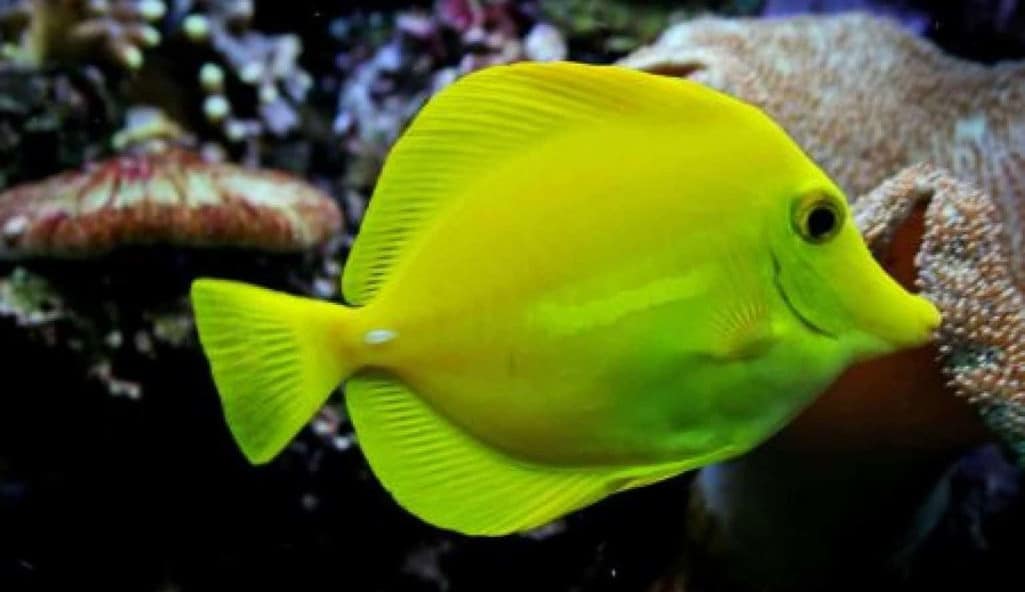
The Yellow Tang (Zebrasoma flavescens) is a subtropical fish that dwells in the Pacific and Indian oceans.
Specifically, they’re mostly found on Japan, Marianna Islands, Marshall Islands, and Hawaii.
This fish loves to swim near reefs. It prefers reef ecosystems which feature mild turbulence. In the wild, the Yellow Tang swims in schools consisting of 8 -20 members.
As the name implies, this fish has a uniform bright coloration of yellow. The Yellow Tang’s color makes it very attractive when swimming in a school.
The average price of the cheapest Yellow Tang is $99.
Yellow Tang isn’t hard to raise with Clownfish. However, note that it may become aggressive.
Furthermore, it’s prone to ich disease. This is a disease that might give spotted white marks on the Yellow Tang and the Clownfish as well.
Yellow Tang Profile
- Other Names: Lemon Sailfish, Somber Surgeonfish, Yellow Sailfin Tang, and Yellow Hawaiian Tang
- Life Span: 30 Years
- Diet: Dried Shrimp, Seaweed, Algae, and Fine-Sliced Veggies
- Preferred Water Condition: Saltwater, Acidic, Warm (22 – 27 degrees Celsius)
- Minimum Tank Requirement: 55 Gallons
- Suitable Tank Mates: Clownfish, Pygmy Angelfish, Lionfish, Wrasses, and Cardinals
Mandarinfish

The Mandarinfish (Synchiropus splendidus) is usually found in the salt waters of Hongkong and Australia.
In the wild, the Mandarinfish loves to swim on shallow lagoons and inshore coral reefs.
The Mandarinfish has a very kaleidoscopic color. The base color of this fish is deep blue.
An orange wavy pattern engulfs then engulfs the base color. The combination of blue and orange make this fish look glamorous.
In connection, its fins may have a greenish or yellowish hue.
The Mandarinfish grows up to 3 inches. A pair of this fish (male and female) is sold at $99.
The Mandarinfish uses a thick coating of slime instead of scales for protection. As a result, it might be prone to parasitic disease.
However, this trait makes Mandarinfish not susceptible to predatory fishes.
Mandarinfish Profile
- Other Names: Mandarin Dragon Net
- Life Span: 4 Years
- Diet: Copepods, Pellets, Brine Shrimp, and Mysis Shrimp
- Preferred Water Condition: Saltwater, Acidic, Warm (23 – 81 degrees Celsius)
- Minimum Tank Requirement: 55 Gallons
- Suitable Tank Mates: Clownfish, Cardinalfish, Sea Horse, and Royal Gramma
Firefish
The Firefish originates from the Pacific and Indian oceans.
Specifically, it dwells on the eastern coast of Africa, the Hawaiian Islands, and Austral Islands near north of the Nansei Islands in Japan.
This fish loves to swim on tropical waters of the Pacific and Indian ocean that have numerous coral reefs. The Firefish loves heavily reefed areas because this is where it gets its diet of planktons and algae.
The Firefish comes in a variety of colors. Some feature a base color of white and additional colors of light red, deep red, and pink.
This fish may reach a maximum size of 4 inches. Right now, its sold for $10 or $20.
You need to be very careful about designing the community tank when raising the Firefish with the Clownfish.
You have to put rocks, marine plants, and reef replicas.
Furthermore, you must install a device that allows the community tank to emulate the current of the Firefish’s natural habitat.
Firefish Profile
- Other Names: Dartfish, Fire Goby, Red Fire Goby, and Magnificent Firefish
- Life Span: 3 Years
- Diet: Zooplankton, Algae, Brine Shrimp, and Fine-Sliced Seafood
- Preferred Water Conditions: Saltwater, Acidic, Warm (22 – 28 degrees Celsius)
- Minimum Tank Requirement: 30 Gallons
- Suitable Tank Mates: Clownfish, Lionfish
Blood Red Fire Shrimp

The Blood Red Fire Shrimp (Lysmata debelius) is a variety of shrimp that’s endemic to the Indo-Pacific.
This crustacean loves to move around on the bottom. It feeds on Algae and small organic particles in the water.
Nature gave the Blood Red Fire Shrimp a vibrant red color. Nevertheless, there are varieties of this crustacean that feature white spots on the head or the body.
The Blood Red Fire Shrimp grows up to 1.2 inches. At present, Blood Red Fire Shrimp sells for $47.
Nighttime makes Blood Red Fire Shrimp very active. It’s not necessarily a nocturnal animal though.
A community tank for the Blood Red Fire Shrimp should have dim areas.
Blood Red Fire Shrimp Profile
- Other Names: Blood Shrimp, Fire Shrimp, and Scarlet Cleaner Shrimp
- Life Span: 2 Years
- Diet: Freeze-Dried Foods, Flakes, and Detritus
- Preferred Water Condition: Saltwater, Acidic, Warm (26 degrees Celsius)
- Minimum Tank Requirement: 30 Gallons
- Suitable Tank Mates: Clownfish, Firefish, Mandarin Dragonet, and Yellow Tang
Hermit Crab

Hermit Crabs (Paguroidea) are scattered on various seas all over the world.
Nevertheless, most are found in the Indo-Pacific region, western Atlantic, and the western Caribbean.
Hermit Crabs love to crawl on the seabed to look for food or shelter. For a quick trivia, the Hermit Crab doesn’t have its shell but occupies the empty shells that dead mollusks leave.
Depending on the specie, the Hermit Crab grows small or may become as big as coconuts.
Furthermore, it may be sold for as cheap as $3 or as expensive as $25.
As I said earlier, the Hermit Crab doesn’t have its shell but uses the shell of mollusks. When raising this with your Clownfish, consider giving it a new shell as it grows.
Hermit Crab Profile
- Other Names: None
- Life Span: 15 Years (depends on species)
- Diet: Commercial Hermit Crab Food. Spinach, Lettuce, Carrots, Brine Shrimps, and Fish Flakes
- Preferred Water Conditions: Saltwater, Humid, Warm (22 degrees Celsius)
- Minimum Tank Requirement: 20 Gallons
- Suitable Tank Mates: Clownfish, Damselfish, Gobies, and Butterfly Fish
Wrasses

This fish happily lives on the tropical and subtropical waters of the Indian Ocean, Pacific Ocean, and the Atlantic Ocean.
There are about 500 known species of Wrasse to date.
Some are captured for community tanks. There are also others that people catch for food.
Due to their popularity, some Wrasse species are getting extinct. An example is the Humphead Wrasse.
In the wild, Wrasses love to swim on rocky shores, sandy sea floors, and coral reefs.
Wrasses aren’t very aggressive. However, they’re prone to nip or charge at fishes with the same color or behavior in the community tank.
Wrasse Profile
- Other Names: Hogfish, Tautog
- Life Span: 30 Years
- Diet: Marine Invertebrates, Parasites
- Preferred Water Conditions: Saltwater, Neutral, Warm (23 – 28 degrees Celsius)
- Minimum Tank Requirement: 100 Gallons
- Suitable Tank Mates: Clownfish, Triggerfish, Grouper, Puffer, and Angelfish
Blennies
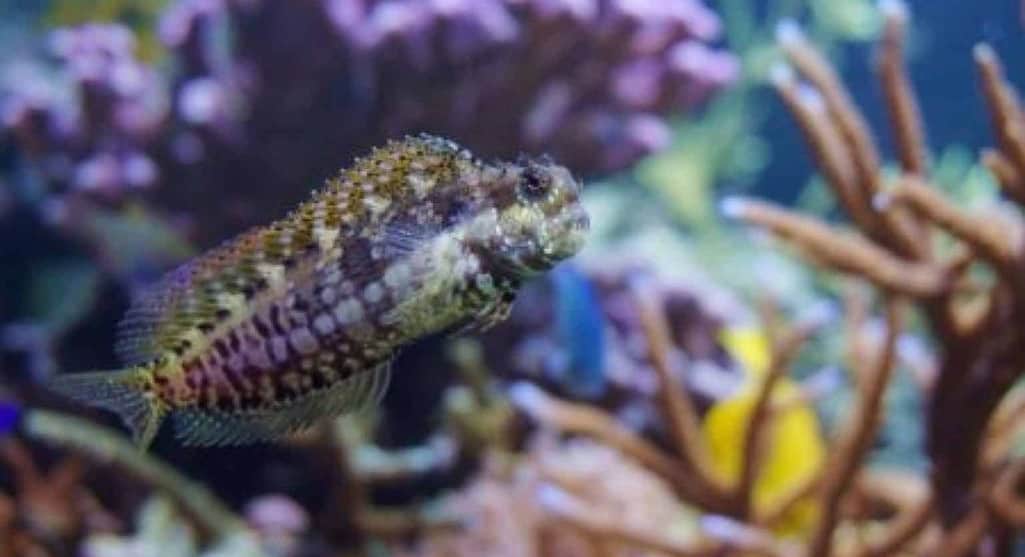
Blennies are found on tropical or cold seas. You can find this fish all over the globe.
Even so, most Blennies that are raised on community tanks come from the Indo-Pacific region.
All Blennies have a streamlined shape which makes them look like mini eels. They may come in colors of brown, black, or orange, yellow, silver, etc.
Also, there are rare ones that have patterns on their body and head.
Most Blennies reach a maximum size of 3 inches. Depending on the specie, Blennies may be as cheap as $15 or as expensive as $40
Blennies are bottom dwellers. They love to swim on the seabed in the wild. Get a gravel or sand substrate if you decide to add Blennies on the Clownfish community tank.
Blenny Profile
- Other Names: None
- Life Span: 2 Years
- Diet: Algae, Small Bits of Vegetables, and Spirulina
- Preferred Water Conditions: Saltwater, Slightly Acidic, Acidic, Warm (22 – 25 degrees Celsius)
- Minimum Tank Requirement: 20 Gallons
- Suitable Tank Mates: Clownfish, Blood Red Fire Shrimp, Pygmy Angelfish, Wrasses, and Filefish
Pufferfish
The Pufferfish is found in most tropic and sub-tropical oceans. Pufferfish lives on the seas of Japan, Philippines, Thailand, and other countries near warm oceans.
Almost all kinds of Pufferfish are poisonous. Surprisingly, Asians treat Pufferfish as a delicacy even if it might kill them when wrongly cooked.
There are about 120 species of Pufferfish that scientists recorded to date.
In 2014, the discovery of a new species of Pufferfish was published in the Ichthyological Research Journal.
Depending on the variety, there are special Pufferfish that may reach 2 feet. The most expensive species of Pufferfish is the Arothron Pufferfish which sells at $500 – $800
Pufferfish Profile
- Other Names: Balloonfish, Blowfish, Globefish, Swellfish, and Puffer
- Life Span: 10 Years
- Diet: Brine Shrimp, Worms, and Dried or Frozen Meats
- Preferred Water Conditions: Depends on the Specie, Neutral, Warm (24-26 degrees Celsius)
- Minimum Tank Requirement: 55 Gallons
- Suitable Tank Mates: Clownfish, Knight Gobies, Red Eye, and Saltwater Mollies
Pseudochromis

Pseudochromis is a tropical fish that originates from the Indian and Pacific oceans.
This fish loves to swim in heavily reefed areas where it can freely look for food and spawn.
There are about 71 species of Pseudochromis to date. They come in colors of orange, black, light orange, yellow, etc.
Out of these, the most beautiful is the Dottyback Pseudochromis which has a neon violet coloration.
Pseudochromis are known for their aggressiveness. Raising at least 3 is enough in Clownfish community tanks.
Be sure to use a large community tank so that they won’t clash with the Clownfish.
Pseudochromis Profile
- Other Names: None
- Life Span: 5 Years
- Diet: Freeze-Dried Worms, Fish Flakes, and Shrimps
- Preferred Water Conditions: Saltwater, Neutral, Warm (26-28 degrees Celsius)
- Minimum Tank Requirement: 80 Gallons
- Suitable Tank Mates: Clownfish, Wrasses, Gobbies, and Blennies
Butterflyfish

The Butterflyfish is a flashy saltwater fish that dwells in the Atlantic, Pacific, and Indian oceans.
This fish loves to swim at depths of 6 – 65 feet. It prefers areas that feature a lot of reefs and oceanic plants.
Butterflyfish is one of the most attractive best clownfish tank mates. This fish may come in the color combinations of black, yellow, white, blue, orange, and red-orange.
The Butterflyfish may reach a maximum size of 8.7 inches.
This fish is prone to Dropsy and Black Ich. Butterflyfish that suffer from Dropsy will have an inflamed belly.
On the other hand, Black Ich gives the Butterflyfish dark spots.
You have to be careful about the nitrate levels of the community tank when raising Butterflyfish, because it may die from nitrate poisoning.
Butterflyfish Profile
- Other Names: None
- Life Span: 10 Years
- Diet: Sponged Based Frozen Treats, Plankton, and Artemia
- Preferred Water Conditions: Saltwater, Acidic, Warm (22 – 27 degrees Celsius)
- Minimum Tank Requirement: 75 Gallons
- Suitable Tank Mates: Clownfish, Damselfish, Tang, Parrotfish, and Hogfish
Banggai Cardinalfish

Preliminary documentation of the Banggai Cardinalfish (Pterapogon kauderni) was done in 1994 by Gerald Allen.
This fish is native only to the Banggai Archipelago in Indonesia.
The Banggai Cardinal Fish loves to swim on calm shallow waters in the Banggai Archipelago. It prefers to swim at seagrasses and coral reefs.
This fish may grow up to 3 inches in captivity. Fish breeders sell the Banggai Cardinalfish for $25 or $30.
This fish is a bit aggressive. However, it’s not prone to attacking Clownfish in the community tank.
Consider putting the hiding place of the Banggai Cardinalfish at the edge if you decide to add Sea Anemone on the community tank.
Banggai Cardinalfish Profile
- Other Names: Banggai Fish
- Life Span: 4 Years
- Diet: Feeder Shrimp, Marine Flesh, and Bloodworms
- Preferred Water Conditions: Saltwater, Acidic, Cool (24 – 26 degrees Celsius)
- Minimum Tank Requirement: 30 Gallons
- Suitable Tank Mates: Clownfish, Dwarf Angelfish, Grunts, and Sweetlips
Peppermint Shrimp

The Peppermint Shrimp dwells on the tropical waters of the Caribbean Sea, It roams at the bottom looking for organic particles on coral reefs, the sand, and debris.
Nature embued this crustacean a bright orange or pinkish color with white spots or lines. Peppermint Shrimp grows up to 2 inches.
Buying a Peppermint Shrimp for your community tank may require an investment of $8 or $15.
Peppermint Shrimp doesn’t like community tanks with lots of lighting.
If you want to see it active, allocate an area that stays dark most of the time and put this crustacean there.
Peppermint Shrimp Profile
- Other Names: Caribbean Cleaner Shrimp, Veined Shrimp, and Candy Cane Shrimp
- Life Span: 2 Years
- Diet: Detritus
- Preferred Water Conditions: Saltwater, Acidic, Cold (18 – 23 degrees Celsius)
- Minimum Tank Requirement: 15 Gallons
- Suitable Tank Mates: Clownfish, Banggai Cardinal Fish, Butterfly Fish, and Dottyback Purplefish
Chromis Damselfish

The Chromis Damselfish is native to Portugal, Angola, Micronesian Islands, Gulf of Guinea Islands, and other parts of the Black Sea, Mediterranean Sea, and East Atlantic.
This fish loves to swim in depths of 1 meter to 12 meters. In the wild, the Chromis Damselfish swims near coral reefs and marine plants.
Chromis Damselfish grows up to 9.8 inches. This is the case for tank raised and wild Chromis.
A single Chromis Damselfish might be sold for $10 – $20
The Chromis Damselfish isn’t prone to disease. However, it’s highly aggressive. This fish is notorious for biting the fingers of its owner and harassing other fish for territory.
When raising Chromis Damselfish with Clownfish, consider switching to a bigger tank and puts lots of hiding places for the Clownfish.
Chromis Damselfish Profile
- Other Names: Demoiselle
- Life Span: 15 Years
- Diet: Eats All Kinds of Food
- Preferred Water Conditions: Saltwater, Slightly Acidic, Warm (22 – 25 degrees Celsius)
- Minimum Tank Requirement: 75 Gallons
- Suitable Tank Mates: Clownfish, Dwarf Angelfish, Dottyback, and Tang
Clownfish Community Tank Basics

Now that you know the best clownfish tank mates, it’s time for you to make a Clownfish community tank.
Here are some of the things that you have to know about making one.
The Minimum Capacity Should Be 100 Gallons
Raising a single Clownfish requires a 30 Gallon tank. However, you’re building a community tank so expect to go big.
For the Clownfish community tank, a 100-gallon tank is a minimum requirement.
The reason for this is simple. Clownfish love to swim around. Also, raising them with tank mates requires lots of additional accessories such as reefs, wavers, and aquatic plants like seaweeds.
There Are No Females
All Clownfish are born as males. But they can change their gender though. This is why you should put no more than two in a small community tank.
As much as possible the numbers of the Clownfish must be even. That said, raising 5, 7, 11, or 13 Clownfish in a community tank might be a bad idea because one will be left out.
Avoid Large Sea Anemones
Clownfish have a thing for Sea Anemones. However, this doesn’t mean that you should put large ones on the community tank.
Small Sea Anemones will do. Also, try getting your hands on varieties which doesn’t sting so much.
By the way, you should be careful when handling Sea Anemones.
Aside from rashes and blisters, being stung by a Sea Anemone might give you chest pains and headaches. Consider wearing gloves.
Invest For Additional Accessories
Clownfish and its tank mates are very sensitive about water. A slight change in temperature or composition of the water’s chemicals might cause them to die.
This is why you should consider buying these accessories for a Clownfish community tank:
- Aquarium Waver
- pH Meter
- Aquarium Filter
- Protein Skimmer
Learn How To Maintain Saltwater
A Clownfish community tank is easy to make. However, maintaining it requires work. It’s because you have to learn how to maintain the saltwater in the fish tank.
As of now, there are no automatic saltwater maintainers for fish tanks. Even if there are any, I doubt that they’ll work well.
For saltwater maintenance, you might have to use salt (for changing salinity) and peat or alkaline buffer (for changing acidity).
For changing temperature, you might have to put ice or pour warm water on the Clownfish community tank.
Lightings are handy too to some extent.
Conclusion
Clownfish are very easy to raise on their own. However, you might have to prepare when making Clownfish community tanks.
Clownfish community tanks require skill and you must learn the fundamentals beforehand to avoid fatal mistakes.
All Clownfish community tanks use saltwater. The tankmates that I showed here are some of the hardiest tank mates for Clownfish that don’t require meticulous saltwater maintenance.
Remember that raising Clownfish also demands that you get Sea Anemones. For raising 4 Clownfish in a community tank, small Sea Anemones will do. Also, try to place them far away from other fishes.
Lastly, stop hesitating about making a Clownfish community tank. It won’t be easy.
However, websites like this exist that give you all the necessary information to make things easier.

